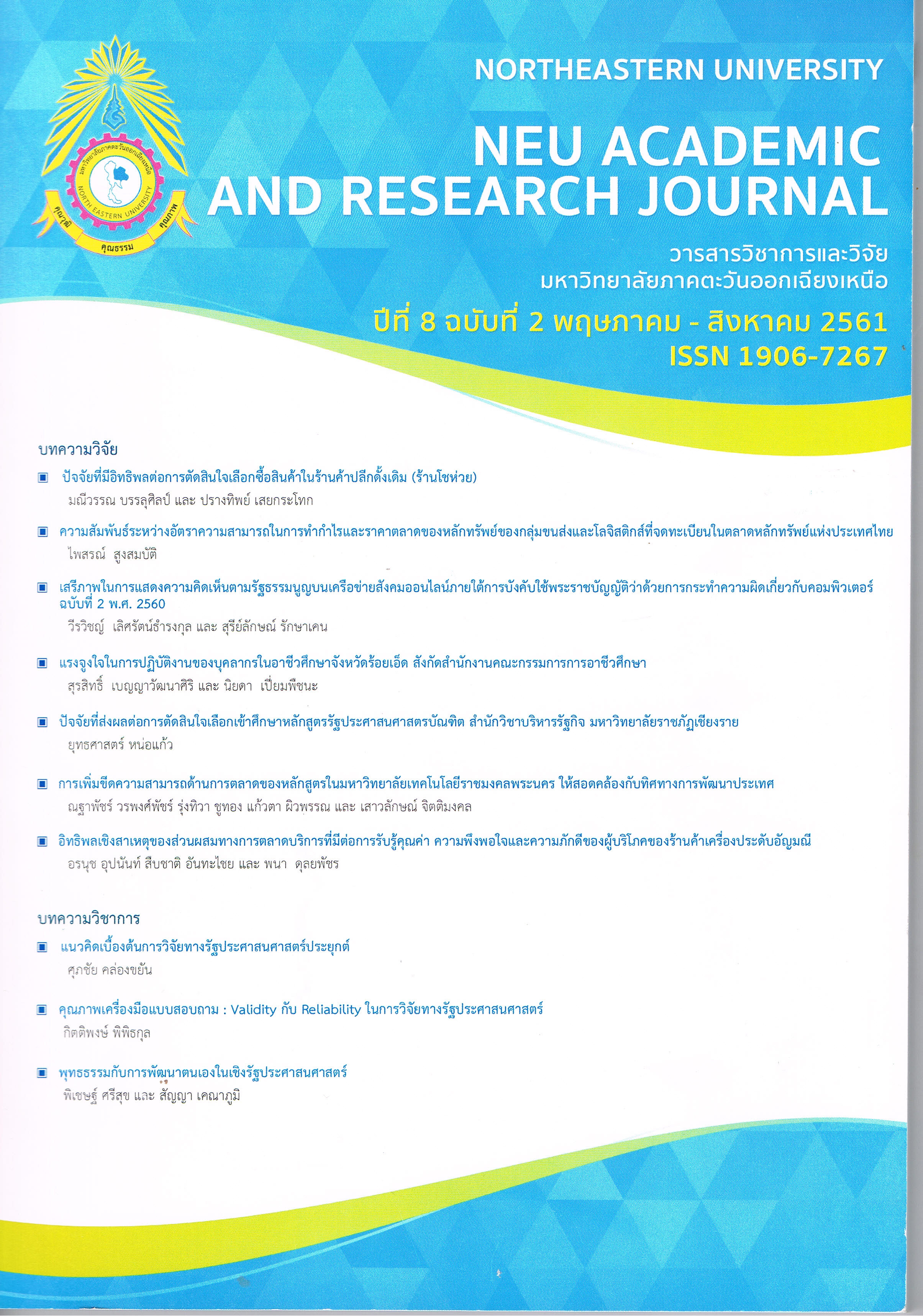The Casual Influences of Service Marketing Mix on Customer Perceived Value, Satisfaction and loyalty of Jewelry Shops
Keywords:
Service Marketing Mix, Values Perception, Satisfaction, Loyalty, JewelryAbstract
The objective of this research was to investigate the causal influences of service marketing mix, values perception, satisfaction and loyalty of customers in jewelry shops in Muang district, Udonthani province. The data were collected from 640 jewelry shop's customers in Udonthani province. The research instrument was a questionnaire. Descriptive statistics were generated using SPSS and the structural equation modeling was obtained by LISREL.
The research results were found that the goodness-of-fit indexes are as p-value of 0.00, Chi-Square (370) of 1,071.07, Relative Chi-Square of 2.89, Goodness of Fit Index (GFI) of 0.90; and Root Mean Square Error of Approximation (RMSEA) of 0.05. The results were shown that: 1) the marketing mix had a positive relationship to satisfaction, value perception and loyalty of customers, 2) the satisfaction had a positive link to customers' loyalty, and 3) the value perception had a positive relation to loyalty.
References
นิวรรณ เตือนใจยา. (2555), การศึกษาเรื่องความสัมพันธ์ของการสื่อสารการตลาดแบบบูรณาการต่อการรับรู้และความพีเพอใจต่อตราสินค้าบิ๊กคาเมร่าที่ส่งผลต่อความภักดีของลูกค้าในเขตกรุงเทพมหานคร.ในเขตกรุงเทพมหานครและปริมณฑล. วารสารการเงิน, การลงทุน, การตลาดและการบริหารธุรกิจ,(3)1, 2-16.
ฤทธิขัย กอศิริวรชัย. (2544). ปัจจัยลส่วนผสมทางการตลาดที่มีต่อผู้บริโภคในการเลือกซื้อเครื่องประดับอัญมณีจากร้านอัญมณี ในเขตอำเภอเมือง จังหวัดเซียงใหม่ วิยานิพนธ์ปริญญาการบริหารธุรกิจมหาบัณฑิต.มหาวิทยาลัยเชียงใหม่.
ศิริพงศ์ พฤทธิพันธุ์, พูลสุข กีรติกุญชร และ อมรศักดิ สิงเสนา, (2554) ปัจจัยด้านความพึงพอใจของลูกค้าที่ส่งผลกระทบต่อความภักดี, กรณีศึกษาเปรียบเทียบระหว่างการบินไทยกับการบินกรุงเทพ. วารสารความพึงพอใจของลูกค้า. 23(91), 51-78.
สถาบันวิจัยและพัฒนาอัญมณีและเครื่องประดับแห่งชาติองค์การมหาชน. (2556). The Gem and Jewelry institute of Thalland Public Organizotion. (ออนไลน์). ค้นเมือ 6 พฤจิกายน 2556, จาก http://www.git.or.th/
สืบชาติ อันทะไชย (2559). แบบจำลองสมการเชิงโครงสร้างทางการตลาด. กรุงเทพฯ.โอ.เอส. พริ้นติ้ง เฮ้าส์.
สุนทรารักษ์ สุทธิจันทร์และ เมธา สุรีรโรจน์, (2555), ปัจจัยที่มีผลต่อความได้เปรียบทางการแข่งขันของอุตสาหกรรมส่งออกอัญมณีและเครื่องบประดับในประเทศไทย. วารสารมหาวิทยาลัยนครพนม,2(2),39-45
อัมพล ซูสนุก และจิดาภา รัตนชัยบรรดาล. (2556), อิทธิพลของส่วนผสมทางการตลาดต่อภาพลักษณ์ตราสินค้าคุณค่าที่รับรู้ ความทีงพอใจ และความจงรักภักดีของผู้บริโภคอาหารสำเร็จรูป CP Fresh Mart ในเขตกรุงเทพมหานคร. วารสารมนุษยศาสตร์ สังคุมศาสตร์, 30(2), 133-154.
Aaker, D.A. (1996). Measuring brand equity across products and markets. California Management Review, 38(3), 102-120.
Anderson, J. C., & Garbing, D. W. (1988). Structural Equation Modeling in Practice: A Review and Recommended Two-Step Approach. Psychological Bulletin, 103(3), 411-423.
Auh, Seigyoung & Michael D. Johnson. (2005). Capability effects in evaluations of satisfaction and loyalty. Journal of Economic Psychology. 26, 35-57.
Ball, D., Coelho, P.S. and Vilares, MJ. (2006). Service personalization and loyalty. Journal of Services Marketing, 20(6), 391-403.
Bloomer, J. & de Ruyter, K. (1998). On the relationship between store image, store satisfaction and store loyalty. European Journal of Marketing, 32(5/6), 499-513.
Bodet, G. (2008). Customer satisfaction and loyalty in service: two concepts, four constructs, several relationships. Journal of Retailing and Consumer Services. 15, 156-162.
Bollen, K. A. (1989). Structural Equations with Latent Variables. NY: John Wiley & Sons, Inc.
Carpenter, J.M. and Fairhurst, A. (2005). Consumer shopping value, satisfaction, and loyalty for retail apparel brands. Journal of Fashion Marketing and Management. 9(3), 256-269.
Caruana, A. (2002). Service loyalty: the effects of service quality and the mediating role of customer satisfaction. European Journal of Marketing, 36(7/8), 811-828.
Efanny, W., Haryanto, J., Kashif, M., Widyanto, H.A. (2018). The relationship between marketing mix and retailer - perceived brand equity. IMP Journal, 12(1), 192-208.
Gallarza, M.G., Gil-Saura, I. & Holbrook, M.B. (2011). The value of value: further excursions on the meaning and role of customer value. Journal of Consumer Behavior. 10, 179-191.
Hair, J.F., Jr., Black, W.C., Babin, B.J., & Anderson, R.E. (2010). Multivariate data analysis. 7th ed. UpperSaddle River, New Jersey: Prentice Hall.
Helgesen, O., Havold, J.I. & Nesset,E. (2010). Impacts of store and chain images on the quality- satisfaction - loyalty process in petrol retailing. Journal of Retailing and Consumer Services, 17(2), 109-118.
Keller, K.L. (1993). Conceptualizing, measuring, and managing customer-based brand equity. Journal of Marke ting, 57, 1-22.
Kumar, V., Ilaria Dalla Pozza, Jaishankar Ganesh. (2013). Revisiting the satisfaction-loyalty relationship: empirical generalizations and directions for future research. Journal of Retailing. 89, 246-262.
Kushwaha, G.S. & Agrawal, S. (2015). An Indian customer surrounding 7P's of service marketing. Journal of Retailing and Consumer Services, 22, 85-95.
McDougall, G.H.G. & Levesque, T. (2000). Customer satisfaction with services: putting perceived value into the equation. Journal of Services Marketing, 14(5), 392-410.
Murali, S., Pugazhendhi, S., Muralidharan, C. (2016). Modeling and investigating the relationship of after sales service quality with customer satisfaction, retention and loyalty - a case study of home appliances business. Journal of Retailing and Consumer Services, 30,67-83.
Oliver, R.L. (1982). An investigation of the interrelationship between consumer (dis) satisfaction and complaint reports. Advances in Consumer Research. 218-222.
Rafig, M. and Ahmed, P.K. (1995). Using the 7Ps as a generic marketing mix: an exploratory survey of UK and European marketing academics. Marketing Intelligence and Planning. 13(9): 4-15.
Steenkamp, J.-B. E. M., & Trijp, H. C. M. v. (1991). The Use of LISREL in Validating Marketing Constructs. International Journal of Research in Marketing, 8(4), 283-300.
Teas, R.K. & Agarwal, S. (2000). The effects of extrinsic product cues on consumers' perceptions of quality, sacrifice, and value. Journal of the Academy of Marketing Science, 28(2), 278-290.
Vessel, P. & Zabkar, V. (2009). Managing customer loyalty through the mediating role of satisfaction in the DIY retail loyalty program. Journal of Retailing and Consumer Services, 16, 396-406.
Yoo, B., Donthu, N. & Lee, S. (2000). An examination of selected marketing mix elements and brand equity. Journal of Academy of Marketing Science, 28(2), 195.
Zeithaml, V.A., Berry, L.L. and Parasuraman, A. (1988), Communication and control process in the delivery of service quality. Journal of Marketing, 52 (April), 35-48.



